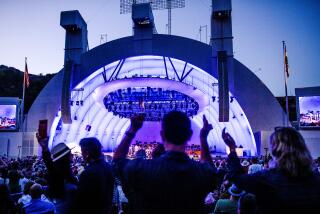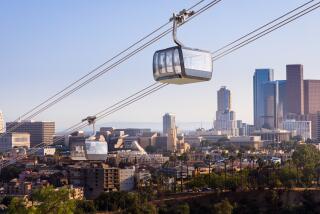Football stadium plan bets many fans would leave cars at home
The developer of a proposed downtown football stadium is counting on a dramatic change in the behavior of L.A. sports fans, releasing a report Thursday that bets 1 in 4 ticket buyers would come to the 72,000-seat venue without a car on weekdays.
With more than 19,000 vehicles expected to flood downtown for games at Farmers Field, Anschutz Entertainment Group’s strategy for traffic hinges, in part, on convincing ticket buyers to travel via the Metro Blue Line, the upcoming Expo Line and other public transit routes.
That approach made AEG President Tim Leiweke sound more like a starry-eyed urban planner than a hardball negotiator for an NFL team. As he celebrated the release of the project’s environmental impact report at a news conference on the steps of City Hall, Leiweke expressed confidence that another 5,000 or more ticket buyers would walk or ride bicycles to games on weekday evenings.
“We have to change people’s habits from the day they buy their first ticket to Farmers Field,” he said.
The push to limit the number of cars arriving at the proposed $1-billion stadium is tied to legislation passed last year to speed the project’s environmental review process. That law requires that AEG operate a stadium with fewer car trips than any other NFL facility in the nation, company officials said.
The environmental impact report, which must be approved by the City Council, assumes that more than 18% of ticket buyers would show up at weekend events without using cars. For weekday games, that figure would reach 27%.
Leiweke’s plans were greeted skeptically by Victor Citrin, who lives near the proposed stadium site and AEG’s L.A. Live entertainment complex. Citrin said the environmental impact report, which runs 10,000 pages and cost $27 million, relies on overly upbeat transit ridership assumptions while downplaying the number of cars that would inundate his Pico-Union neighborhood.
“This is Los Angeles. This city was built around the car,” he said. “For somebody to come here from Buena Park on public transit — I don’t think it’s going to happen.”
AEG contends its projections are not out of line with other major venues, noting in its report that more than 30% of visitors to Target Field in Minneapolis and more than a third of ticket buyers at San Francisco’s AT&T Park arrive by public transit. Leiweke said AEG plans to give ticket buyers discounts and even bump them up in line for available tickets if they take public transit.
“We just have to teach people and reward them for using mass transportation,” he said.
The stadium site is moments away from the congested interchange of the 10 and 110 freeways. But it is also close to a rail station that serves the Metro Blue Line between downtown and Long Beach and will soon handle the Expo Line, which will take passengers as far as Culver City later this year.
The stadium would also host events other than football games, such as concerts and international soccer matches.
Transportation planning consultant Ryan Snyder, who serves as a lecturer at UCLA, said he would like to see AEG focus less on freeway improvements for cars and more on the creation of bus-only lanes on corridors leading to the stadium. But he also said the transit assumptions made by AEG are achievable.
“I’m willing to believe those numbers,” he said.
AEG plans to spend $35 million on transportation improvements, including $10 million to upgrade the Blue Line station on Pico Boulevard. Another $2.4 million would go toward planning for an additional lane on the northbound 101 Freeway between the downtown four-level interchange and Alvarado Street in Echo Park.
The company also plans to upgrade traffic signal controls at 73 intersections and widen crosswalks in a dozen locations. Yet even with those investments, downtown would see “significant, unavoidable impacts” at dozens of intersections.
After Saturday games, such effects would be felt at 42 intersections. Before weekday games, that number would grow to 72, the report said. The project also would have significant effects on freeway onramps after AEG put its traffic management plan in place. That includes six locations on weekday evenings and as many as 11 on Saturdays.
“No feasible physical improvement mitigation measures were identified for these impacts,” the report said.
The public will have 45 days to comment on the document. AEG hopes for a City Council vote on the document by the end of the summer.
Traffic is not the only issue analyzed in the report, which is 17 volumes. On other environment matters, it concludes that:
• The stadium and convention center wing would have a less than significant impact on climate change, in part because construction would involve “green building” features such as energy efficient lights and up-to-date air conditioning systems.
• Stadium lighting would have a significant impact on certain nights when the city has low cloud cover.
• The project would substantially alter the visual resources of the area, partly by adding more than 30 digital signs to the stadium and convention center — 14 of which would face the freeway.
Those electronic signs would change images every eight seconds, a prospect that alarms Dennis Hathaway, president of the Coalition to Ban Billboard Blight. Motorists would see those images just as they merge onto lanes of the 110 Freeway, he said.
“I think it’s the height of irresponsibility to put those potential distractions right there,” he said.
More to Read
Start your day right
Sign up for Essential California for news, features and recommendations from the L.A. Times and beyond in your inbox six days a week.
You may occasionally receive promotional content from the Los Angeles Times.







